Financial Accounting Report: Reporting Entities and Characteristics
VerifiedAdded on 2021/04/19
|7
|1196
|25
Report
AI Summary
This financial accounting report delves into the concept of reporting entities, as defined by Statement of Accounting Concepts (SAC 1), and their role in preparing General Purpose Financial Reports (GPFRs). It explores the factors that determine a reporting entity, emphasizing the importance of ownership, economic or political significance, and financial characteristics. The report then examines the fundamental characteristics of useful financial information, namely relevance and faithful representation, and the enhancing characteristics, including comparability, verifiability, timeliness, and understandability. Examples are provided to illustrate these characteristics, such as net profit margin for relevance and revenue for faithful representation. The report references key academic sources to support its analysis and provides a comprehensive overview of the principles and characteristics that govern financial accounting and the usefulness of financial information.
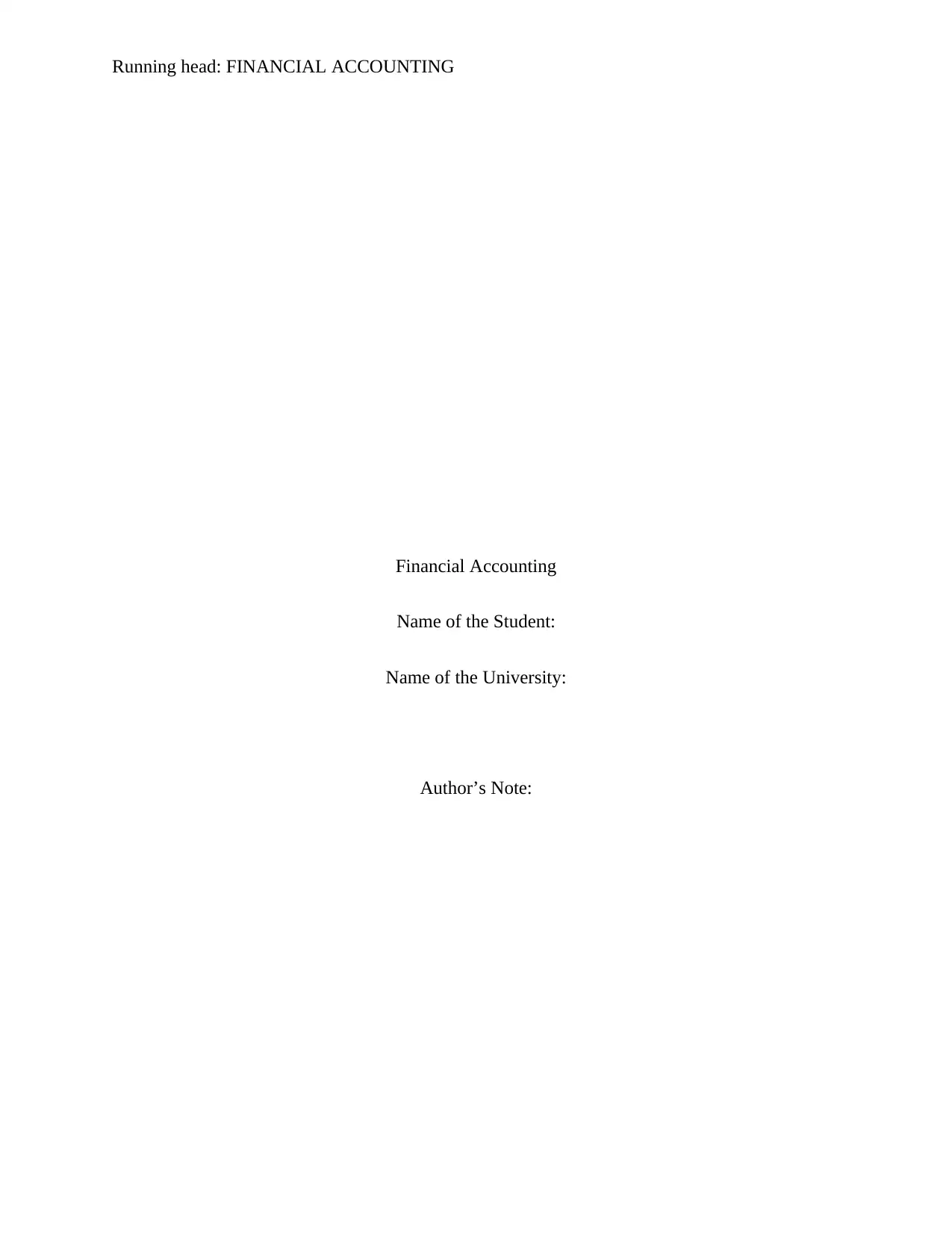
Running head: FINANCIAL ACCOUNTING
Financial Accounting
Name of the Student:
Name of the University:
Author’s Note:
Financial Accounting
Name of the Student:
Name of the University:
Author’s Note:
Paraphrase This Document
Need a fresh take? Get an instant paraphrase of this document with our AI Paraphraser
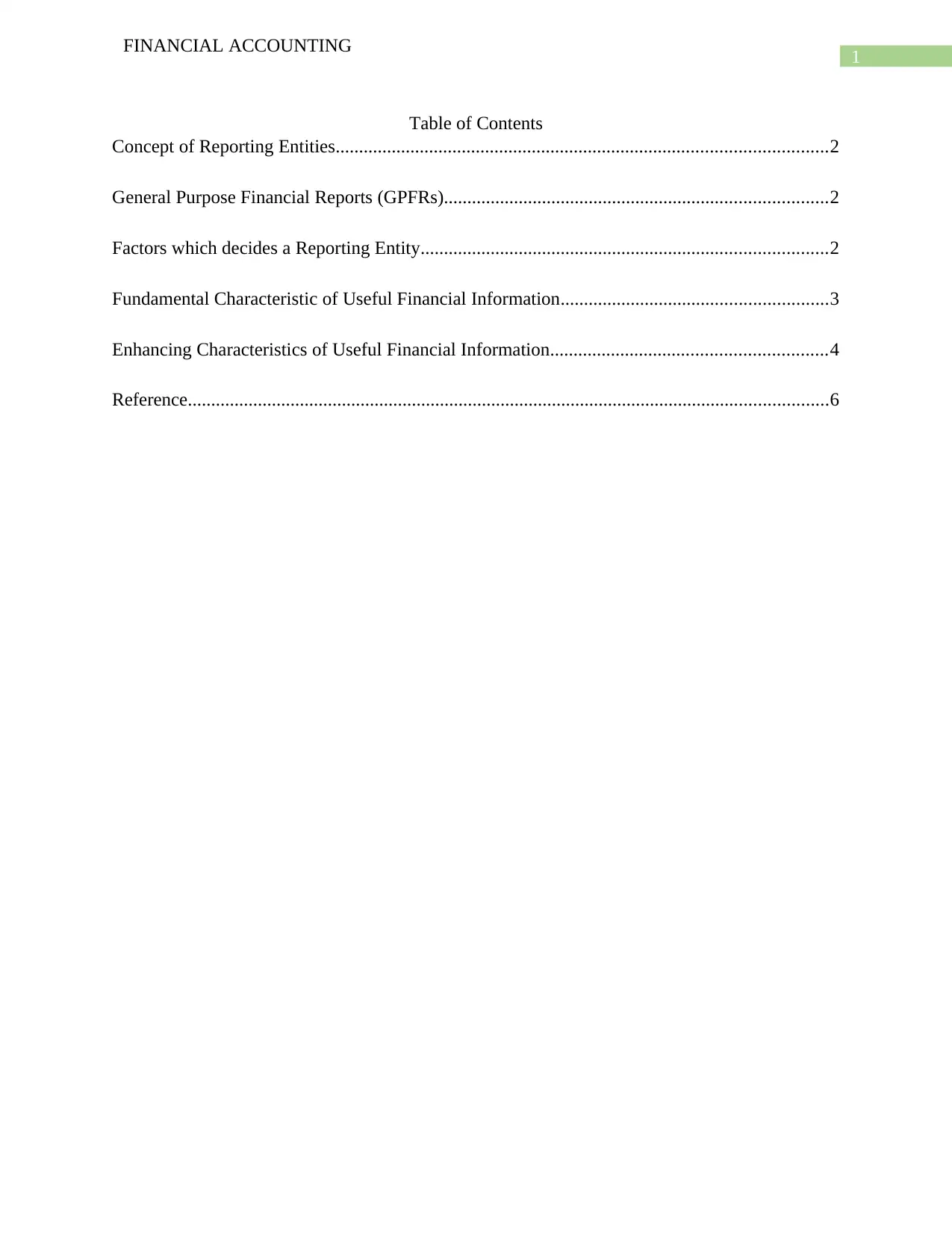
1
FINANCIAL ACCOUNTING
Table of Contents
Concept of Reporting Entities.........................................................................................................2
General Purpose Financial Reports (GPFRs)..................................................................................2
Factors which decides a Reporting Entity.......................................................................................2
Fundamental Characteristic of Useful Financial Information.........................................................3
Enhancing Characteristics of Useful Financial Information...........................................................4
Reference.........................................................................................................................................6
FINANCIAL ACCOUNTING
Table of Contents
Concept of Reporting Entities.........................................................................................................2
General Purpose Financial Reports (GPFRs)..................................................................................2
Factors which decides a Reporting Entity.......................................................................................2
Fundamental Characteristic of Useful Financial Information.........................................................3
Enhancing Characteristics of Useful Financial Information...........................................................4
Reference.........................................................................................................................................6
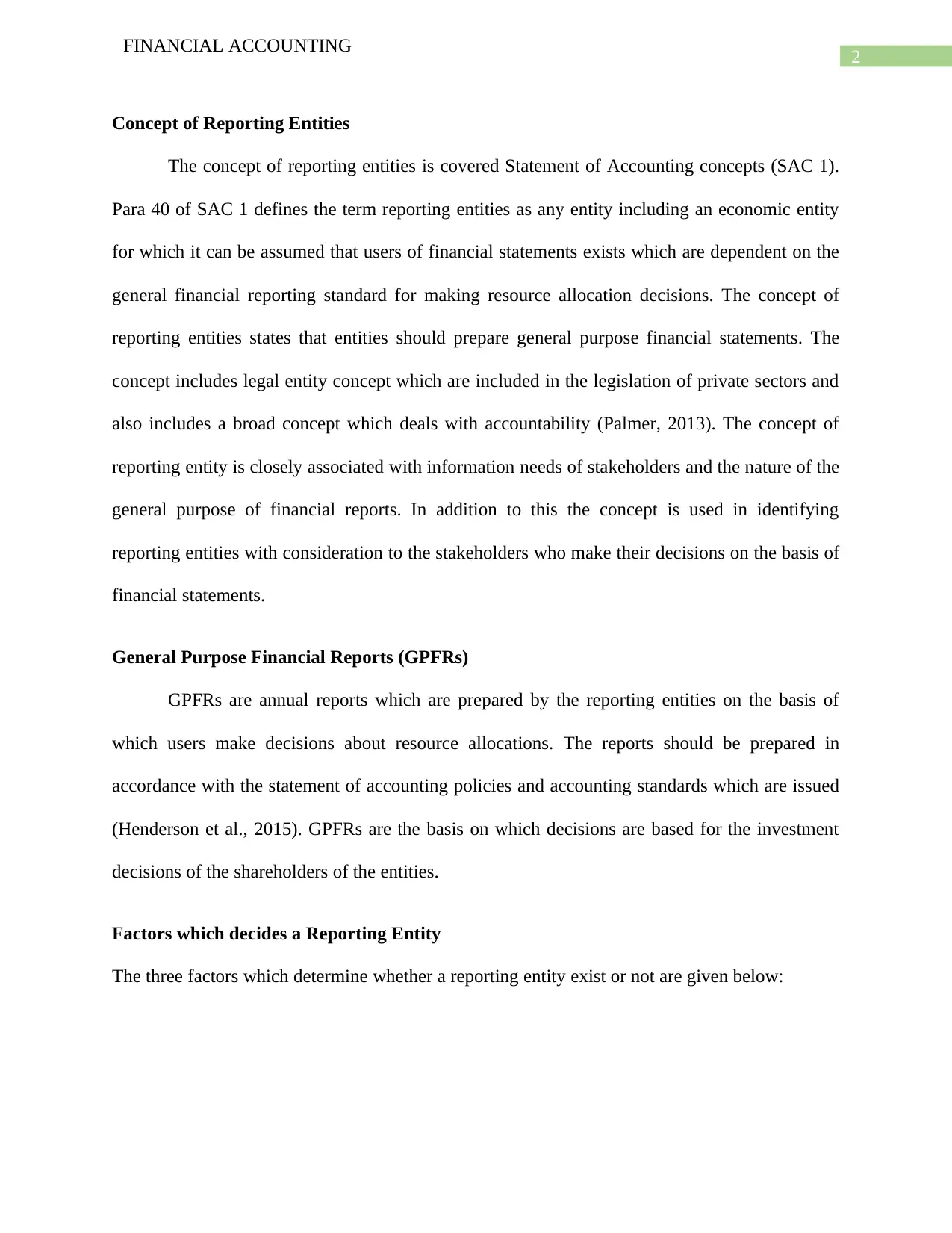
2
FINANCIAL ACCOUNTING
Concept of Reporting Entities
The concept of reporting entities is covered Statement of Accounting concepts (SAC 1).
Para 40 of SAC 1 defines the term reporting entities as any entity including an economic entity
for which it can be assumed that users of financial statements exists which are dependent on the
general financial reporting standard for making resource allocation decisions. The concept of
reporting entities states that entities should prepare general purpose financial statements. The
concept includes legal entity concept which are included in the legislation of private sectors and
also includes a broad concept which deals with accountability (Palmer, 2013). The concept of
reporting entity is closely associated with information needs of stakeholders and the nature of the
general purpose of financial reports. In addition to this the concept is used in identifying
reporting entities with consideration to the stakeholders who make their decisions on the basis of
financial statements.
General Purpose Financial Reports (GPFRs)
GPFRs are annual reports which are prepared by the reporting entities on the basis of
which users make decisions about resource allocations. The reports should be prepared in
accordance with the statement of accounting policies and accounting standards which are issued
(Henderson et al., 2015). GPFRs are the basis on which decisions are based for the investment
decisions of the shareholders of the entities.
Factors which decides a Reporting Entity
The three factors which determine whether a reporting entity exist or not are given below:
FINANCIAL ACCOUNTING
Concept of Reporting Entities
The concept of reporting entities is covered Statement of Accounting concepts (SAC 1).
Para 40 of SAC 1 defines the term reporting entities as any entity including an economic entity
for which it can be assumed that users of financial statements exists which are dependent on the
general financial reporting standard for making resource allocation decisions. The concept of
reporting entities states that entities should prepare general purpose financial statements. The
concept includes legal entity concept which are included in the legislation of private sectors and
also includes a broad concept which deals with accountability (Palmer, 2013). The concept of
reporting entity is closely associated with information needs of stakeholders and the nature of the
general purpose of financial reports. In addition to this the concept is used in identifying
reporting entities with consideration to the stakeholders who make their decisions on the basis of
financial statements.
General Purpose Financial Reports (GPFRs)
GPFRs are annual reports which are prepared by the reporting entities on the basis of
which users make decisions about resource allocations. The reports should be prepared in
accordance with the statement of accounting policies and accounting standards which are issued
(Henderson et al., 2015). GPFRs are the basis on which decisions are based for the investment
decisions of the shareholders of the entities.
Factors which decides a Reporting Entity
The three factors which determine whether a reporting entity exist or not are given below:
⊘ This is a preview!⊘
Do you want full access?
Subscribe today to unlock all pages.

Trusted by 1+ million students worldwide
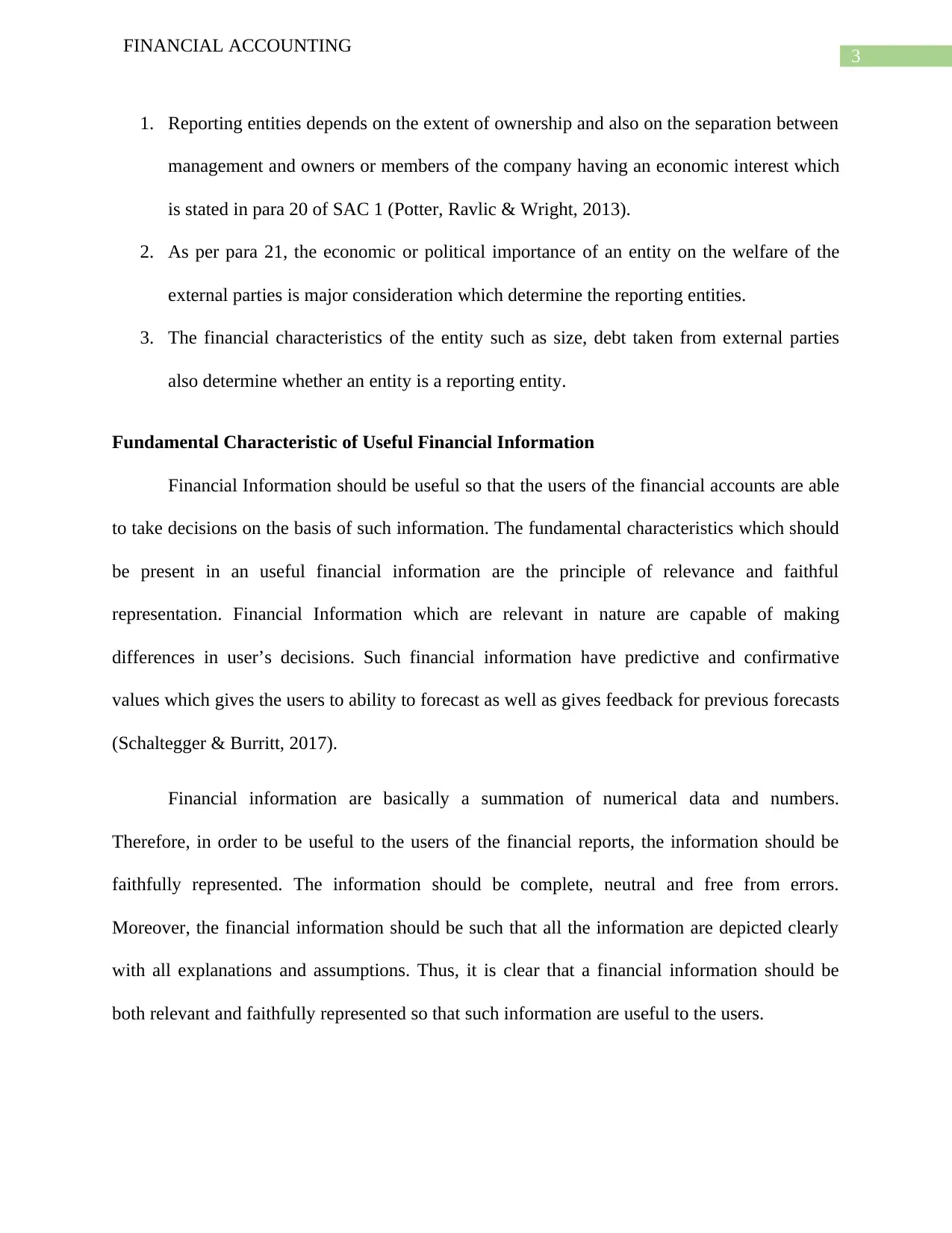
3
FINANCIAL ACCOUNTING
1. Reporting entities depends on the extent of ownership and also on the separation between
management and owners or members of the company having an economic interest which
is stated in para 20 of SAC 1 (Potter, Ravlic & Wright, 2013).
2. As per para 21, the economic or political importance of an entity on the welfare of the
external parties is major consideration which determine the reporting entities.
3. The financial characteristics of the entity such as size, debt taken from external parties
also determine whether an entity is a reporting entity.
Fundamental Characteristic of Useful Financial Information
Financial Information should be useful so that the users of the financial accounts are able
to take decisions on the basis of such information. The fundamental characteristics which should
be present in an useful financial information are the principle of relevance and faithful
representation. Financial Information which are relevant in nature are capable of making
differences in user’s decisions. Such financial information have predictive and confirmative
values which gives the users to ability to forecast as well as gives feedback for previous forecasts
(Schaltegger & Burritt, 2017).
Financial information are basically a summation of numerical data and numbers.
Therefore, in order to be useful to the users of the financial reports, the information should be
faithfully represented. The information should be complete, neutral and free from errors.
Moreover, the financial information should be such that all the information are depicted clearly
with all explanations and assumptions. Thus, it is clear that a financial information should be
both relevant and faithfully represented so that such information are useful to the users.
FINANCIAL ACCOUNTING
1. Reporting entities depends on the extent of ownership and also on the separation between
management and owners or members of the company having an economic interest which
is stated in para 20 of SAC 1 (Potter, Ravlic & Wright, 2013).
2. As per para 21, the economic or political importance of an entity on the welfare of the
external parties is major consideration which determine the reporting entities.
3. The financial characteristics of the entity such as size, debt taken from external parties
also determine whether an entity is a reporting entity.
Fundamental Characteristic of Useful Financial Information
Financial Information should be useful so that the users of the financial accounts are able
to take decisions on the basis of such information. The fundamental characteristics which should
be present in an useful financial information are the principle of relevance and faithful
representation. Financial Information which are relevant in nature are capable of making
differences in user’s decisions. Such financial information have predictive and confirmative
values which gives the users to ability to forecast as well as gives feedback for previous forecasts
(Schaltegger & Burritt, 2017).
Financial information are basically a summation of numerical data and numbers.
Therefore, in order to be useful to the users of the financial reports, the information should be
faithfully represented. The information should be complete, neutral and free from errors.
Moreover, the financial information should be such that all the information are depicted clearly
with all explanations and assumptions. Thus, it is clear that a financial information should be
both relevant and faithfully represented so that such information are useful to the users.
Paraphrase This Document
Need a fresh take? Get an instant paraphrase of this document with our AI Paraphraser
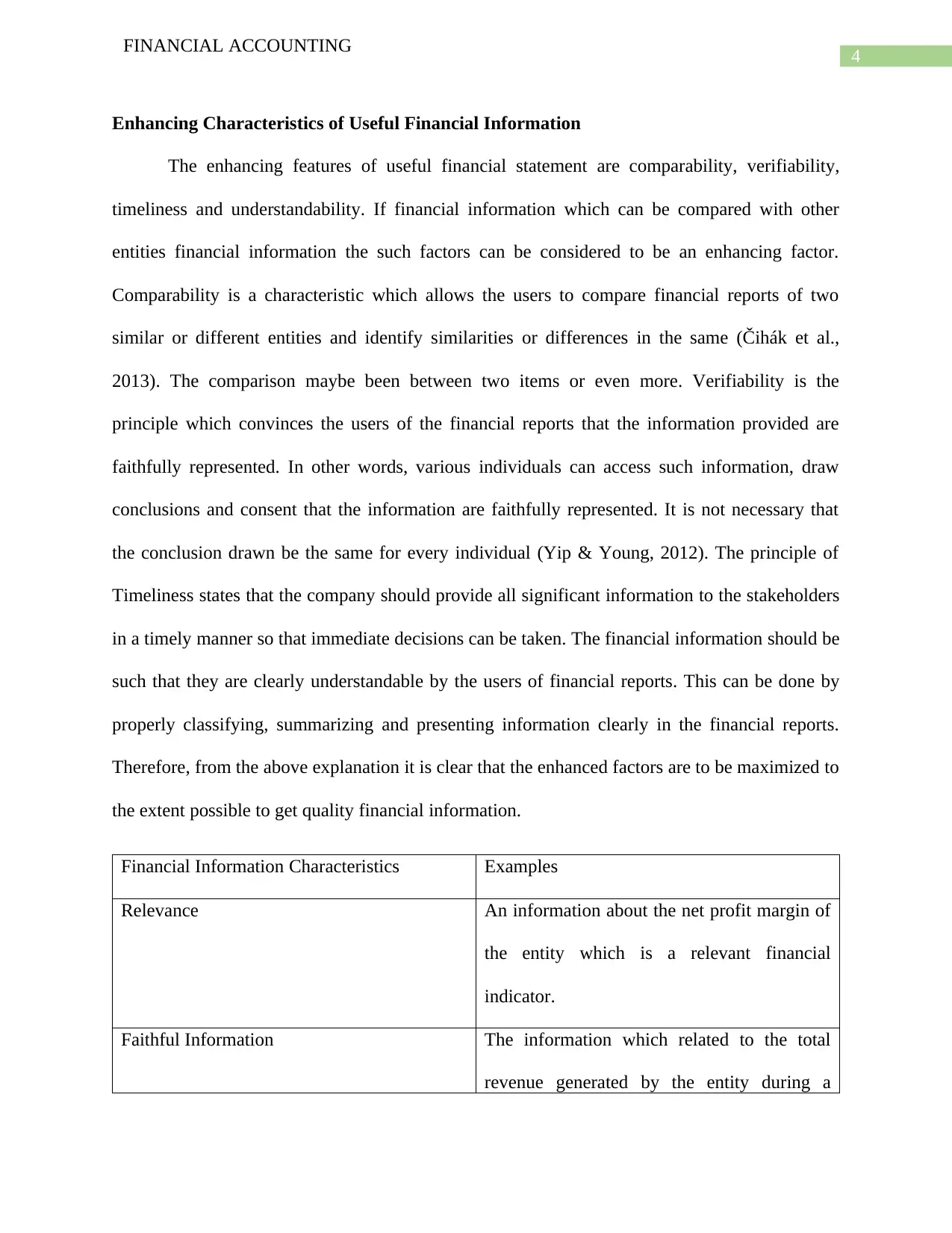
4
FINANCIAL ACCOUNTING
Enhancing Characteristics of Useful Financial Information
The enhancing features of useful financial statement are comparability, verifiability,
timeliness and understandability. If financial information which can be compared with other
entities financial information the such factors can be considered to be an enhancing factor.
Comparability is a characteristic which allows the users to compare financial reports of two
similar or different entities and identify similarities or differences in the same (Čihák et al.,
2013). The comparison maybe been between two items or even more. Verifiability is the
principle which convinces the users of the financial reports that the information provided are
faithfully represented. In other words, various individuals can access such information, draw
conclusions and consent that the information are faithfully represented. It is not necessary that
the conclusion drawn be the same for every individual (Yip & Young, 2012). The principle of
Timeliness states that the company should provide all significant information to the stakeholders
in a timely manner so that immediate decisions can be taken. The financial information should be
such that they are clearly understandable by the users of financial reports. This can be done by
properly classifying, summarizing and presenting information clearly in the financial reports.
Therefore, from the above explanation it is clear that the enhanced factors are to be maximized to
the extent possible to get quality financial information.
Financial Information Characteristics Examples
Relevance An information about the net profit margin of
the entity which is a relevant financial
indicator.
Faithful Information The information which related to the total
revenue generated by the entity during a
FINANCIAL ACCOUNTING
Enhancing Characteristics of Useful Financial Information
The enhancing features of useful financial statement are comparability, verifiability,
timeliness and understandability. If financial information which can be compared with other
entities financial information the such factors can be considered to be an enhancing factor.
Comparability is a characteristic which allows the users to compare financial reports of two
similar or different entities and identify similarities or differences in the same (Čihák et al.,
2013). The comparison maybe been between two items or even more. Verifiability is the
principle which convinces the users of the financial reports that the information provided are
faithfully represented. In other words, various individuals can access such information, draw
conclusions and consent that the information are faithfully represented. It is not necessary that
the conclusion drawn be the same for every individual (Yip & Young, 2012). The principle of
Timeliness states that the company should provide all significant information to the stakeholders
in a timely manner so that immediate decisions can be taken. The financial information should be
such that they are clearly understandable by the users of financial reports. This can be done by
properly classifying, summarizing and presenting information clearly in the financial reports.
Therefore, from the above explanation it is clear that the enhanced factors are to be maximized to
the extent possible to get quality financial information.
Financial Information Characteristics Examples
Relevance An information about the net profit margin of
the entity which is a relevant financial
indicator.
Faithful Information The information which related to the total
revenue generated by the entity during a
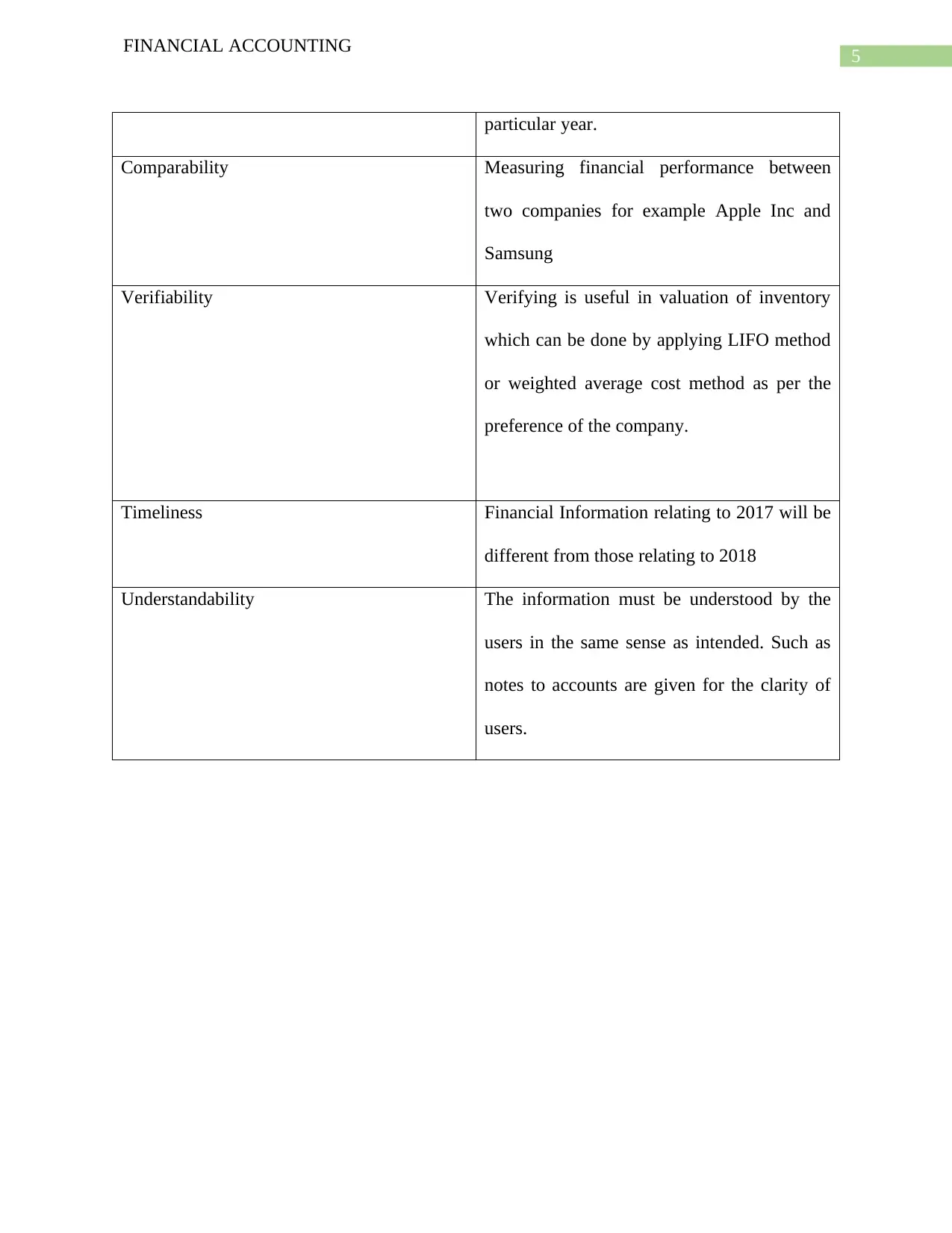
5
FINANCIAL ACCOUNTING
particular year.
Comparability Measuring financial performance between
two companies for example Apple Inc and
Samsung
Verifiability Verifying is useful in valuation of inventory
which can be done by applying LIFO method
or weighted average cost method as per the
preference of the company.
Timeliness Financial Information relating to 2017 will be
different from those relating to 2018
Understandability The information must be understood by the
users in the same sense as intended. Such as
notes to accounts are given for the clarity of
users.
FINANCIAL ACCOUNTING
particular year.
Comparability Measuring financial performance between
two companies for example Apple Inc and
Samsung
Verifiability Verifying is useful in valuation of inventory
which can be done by applying LIFO method
or weighted average cost method as per the
preference of the company.
Timeliness Financial Information relating to 2017 will be
different from those relating to 2018
Understandability The information must be understood by the
users in the same sense as intended. Such as
notes to accounts are given for the clarity of
users.
⊘ This is a preview!⊘
Do you want full access?
Subscribe today to unlock all pages.

Trusted by 1+ million students worldwide
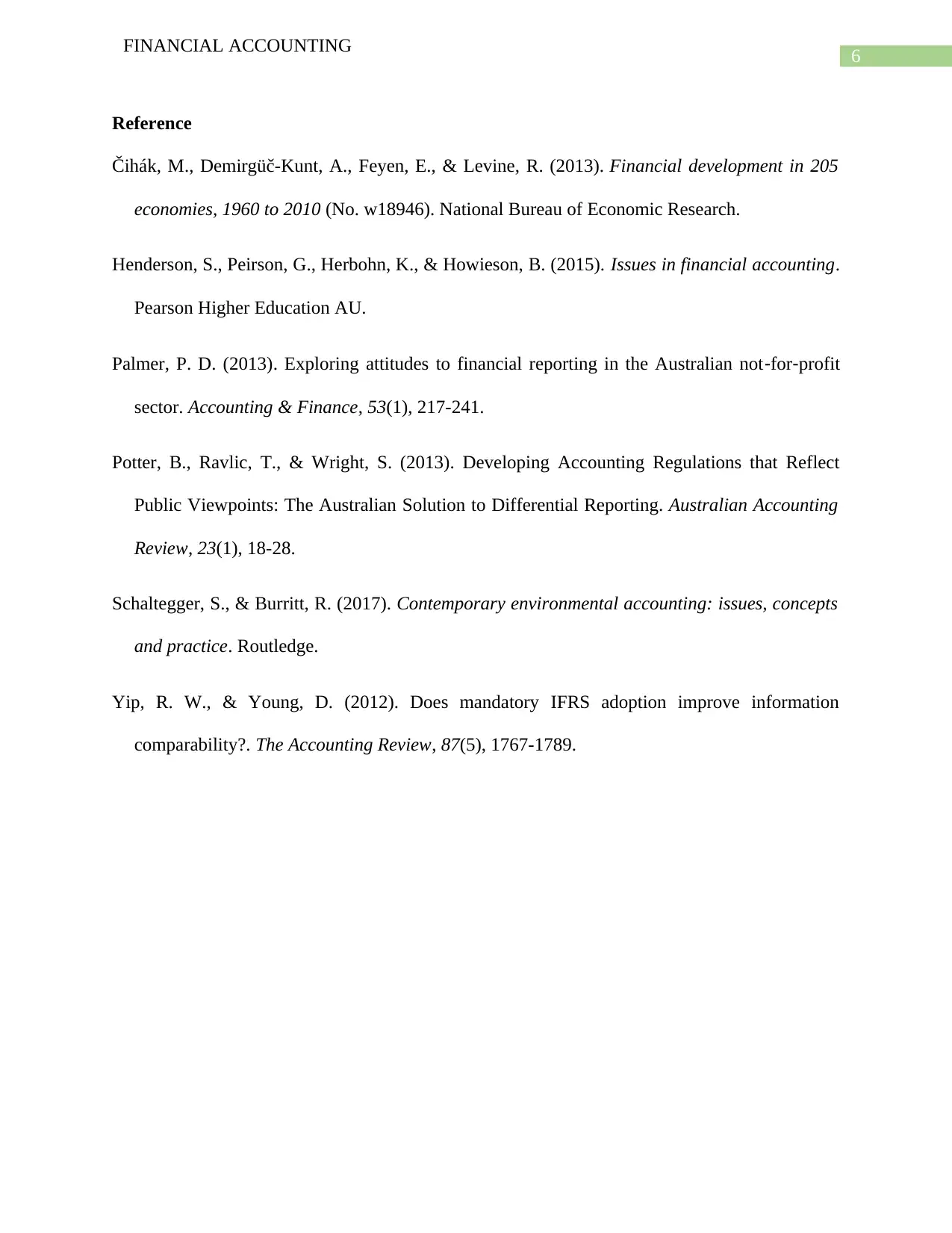
6
FINANCIAL ACCOUNTING
Reference
Čihák, M., Demirgüč-Kunt, A., Feyen, E., & Levine, R. (2013). Financial development in 205
economies, 1960 to 2010 (No. w18946). National Bureau of Economic Research.
Henderson, S., Peirson, G., Herbohn, K., & Howieson, B. (2015). Issues in financial accounting.
Pearson Higher Education AU.
Palmer, P. D. (2013). Exploring attitudes to financial reporting in the Australian not‐for‐profit
sector. Accounting & Finance, 53(1), 217-241.
Potter, B., Ravlic, T., & Wright, S. (2013). Developing Accounting Regulations that Reflect
Public Viewpoints: The Australian Solution to Differential Reporting. Australian Accounting
Review, 23(1), 18-28.
Schaltegger, S., & Burritt, R. (2017). Contemporary environmental accounting: issues, concepts
and practice. Routledge.
Yip, R. W., & Young, D. (2012). Does mandatory IFRS adoption improve information
comparability?. The Accounting Review, 87(5), 1767-1789.
FINANCIAL ACCOUNTING
Reference
Čihák, M., Demirgüč-Kunt, A., Feyen, E., & Levine, R. (2013). Financial development in 205
economies, 1960 to 2010 (No. w18946). National Bureau of Economic Research.
Henderson, S., Peirson, G., Herbohn, K., & Howieson, B. (2015). Issues in financial accounting.
Pearson Higher Education AU.
Palmer, P. D. (2013). Exploring attitudes to financial reporting in the Australian not‐for‐profit
sector. Accounting & Finance, 53(1), 217-241.
Potter, B., Ravlic, T., & Wright, S. (2013). Developing Accounting Regulations that Reflect
Public Viewpoints: The Australian Solution to Differential Reporting. Australian Accounting
Review, 23(1), 18-28.
Schaltegger, S., & Burritt, R. (2017). Contemporary environmental accounting: issues, concepts
and practice. Routledge.
Yip, R. W., & Young, D. (2012). Does mandatory IFRS adoption improve information
comparability?. The Accounting Review, 87(5), 1767-1789.
1 out of 7
Related Documents
Your All-in-One AI-Powered Toolkit for Academic Success.
+13062052269
info@desklib.com
Available 24*7 on WhatsApp / Email
![[object Object]](/_next/static/media/star-bottom.7253800d.svg)
Unlock your academic potential
Copyright © 2020–2025 A2Z Services. All Rights Reserved. Developed and managed by ZUCOL.





